By Keith Austin
Ismail Kadare, who died this week aged 88, might well be the most famous writer nobody has ever heard of outside the literary world. He wrote 80 novels, plays, screenplays, poetry, essays and story collections and his work has been published in 45 languages.
In 2005 he received the inaugural Man Booker International Prize for his work, and he was nominated for the Nobel Prize in Literature 15 times.
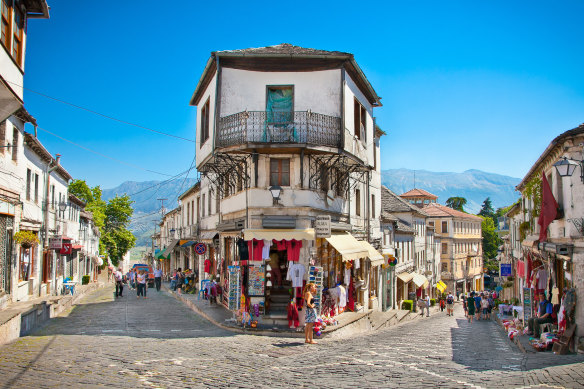
Streets of Gjirokaster … “It was a slanted city, set at a sharper angle than perhaps any other city on Earth, and it defied the laws of architecture and city planning”.Credit: Getty Images
Kadare had been compared to Kafka and Orwell, to Gabriel Garcia Marquez, Milan Kundera and Balzac. In his native Albania he studied in the schools but in the past often found himself at odds with the one-party communist regime of paranoid former dictator Enver Hoxha, who ruled this Adriatic country with an iron fist from 1946 until his death in 1985.
Kadare and Hoxha might have been poles apart politically and morally, but they did have one thing in common: they were both born in the medieval city of Gjirokaster, in the country’s south.
Hoxha’s home is no longer there. It burnt down in the early 1960s and is now the site of the Ethnographic Museum, but Kadare bequeathed his old home to the nation, and it’s now a museum dedicated to the man, his life and works.
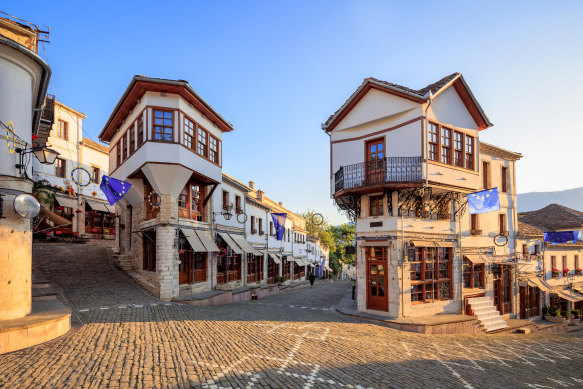
Albania’s Gjirokaster has unique medieval architecture.Credit: iStock
The nearest big conurbation to Gjirokaster is Saranda, a port and seaside tourist town on the Albanian Riviera, as this region is increasingly described. Sitting slap-bang opposite the Greek island of Corfu (regular daily ferries connect the two), Saranda is very much a flop-and-drop kind of place.
At the height of the season it positively bursts with Italians (and the occasional hardy Brit) taking advantage of the relatively cheap lifestyle, glassy waters, and hot Mediterranean weather.
The handful of mid-sized cruise ships that ply the Adriatic coast do occasionally stop in at Saranda but they never stay overnight; it’s just not that sort of town. Instead, the passengers tend to fall off the ship straight on to coaches that take them to Butrint, an ancient Greek and Roman city just 20 minutes south, or to Gjirokaster, a 45-minute drive into Albania’s rugged, mountainous interior.
They will not be beating a path to the Kadare house, though. Despite the literary and historical pulls of Kadare and Hoxha, it’s the city itself that’s the attraction.
Aerial photographs of it adorn the many billboards along Saranda’s seaside promenade, often lumped in with Butrint and Blue Eye (a water spring where the startingly blue water is clear to a depth of more than 50 metres) as a day trip tourist trifecta.
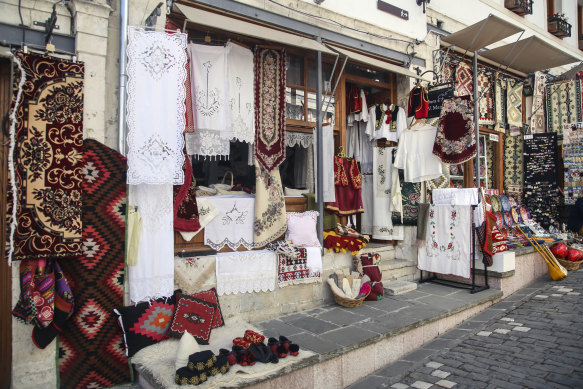
Traditional souvenir shop in Gjirokaster.Credit: Getty Images
It was on my “To Do” list even without the Kadare connection. After all, who could resist a medieval castle perched on a vertiginous rock in the middle of a plain like some giant, rocky thumbs up? In the photographs it reminded me of the castle in Mervyn Peake’s Gormenghast trilogy. This was reason enough to visit, but then along came Mina.
Mina works in the only bookshop in Saranda to sell English language books, and it was she who recommended Kadare’s Chronicle in Stone, his fictional account of growing up in Gjirokaster during World War II. Not only did it open my eyes to an exceptional writer but his descriptions of Gjirokaster and its history made a visit compulsory. Suddenly the To Do list became the Must See list.
Gjirokaster first enters historical consciousness in 1336 as a Byzantine possession and in 1418 was incorporated into the Ottoman Empire, from which it gained independence in 1912. The came World War II and occupation by the Italians, the Greeks, the Italians again, and then the Germans. Sometimes all in the same day.
As Kadare wrote in Chronicle in Stone: “At 10 in the morning on Thursday the Italians came back, marching in under freezing rain. They stayed only 30 hours. Six hours later the Greeks were back. The same thing happened all over again in the second week of November.”
But it is his descriptions of the city itself that are the catalyst for me to jump on the coach heading for Tirana (you transfer part-way and take a second, smaller van to the foot of Gjirokaster hill). It is, he writes, a city that “rejected all comparisons”, where everything was “old and made of stone”.
He adds: “It was a slanted city, set at a sharper angle than perhaps any other city on Earth, and it defied the laws of architecture and city planning. The top of one house might graze the foundation of another … a very strange city indeed. In some places you could walk down the street, stretch out your arm, and hang your hat on a minaret. Many things in it were simply bizarre, and others seemed to belong in a dream.”
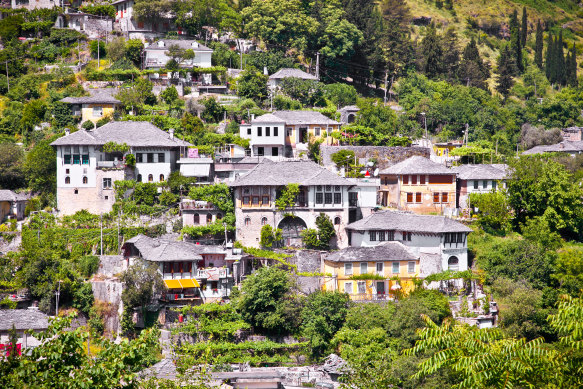
The steep slopes of Gijirokaster.Credit: Getty Images/iStockphoto
While I was in Saranda, a local described the explosion of concrete apartment blocks and part-finished hotels that litter the geological bowl of the town as looking like a dump truck had shed its load down the hillside.
Gjirokaster is the opposite. As Kadare describes it: “The fortress was indeed very old. It had given birth to the city, and our houses resembled the citadel the way children look like their mothers.”
Plenty of taxi drivers will drop you at the top of the hill by the Ottoman citadel but we decided to walk, just following our noses upwards along snaking, cobblestoned streets set at vertiginous, calf-killing angles. It is, indeed, a city of made of stone, an Escher drawing where streets seem to set off at oblique angles to crash into alleyways that, in turn, reveal small squares that look down on layer upon layer of oblique, grey stone roofs and Kadare’s “intolerably tall” houses.
Of course, there would have been fewer (if any) hotels, restaurants, cafes, bars, walking tours, and souvenir shops in Kadare’s day. Then again, it wasn’t a UNESCO World Heritage Site then, either.
Kadare would have been long gone, too, when Hoxha ordered the building of a secret nuclear bunker under the city in the 1970s. This, along with the 173,000 small arms bunkers that still litter the country, is evidence of both Hoxha’s paranoia and the prevailing fears of the time.
Today, the Cold War Tunnel Museum is open to the public for a mere 200 lek. That’s not a lot of money but it’s just as well, as the tours of the 800-metre, 59-room bunker complex are perfunctory at best and led by young guides who sound like they’re reciting a shopping list.
There are a few remnants in the rooms as they were back in the day but when original magazines and paperwork are just left around to yellow and crumble with age, rather than be mounted or laminated, you know mere lip service is being paid.
Afterwards, we make our way to the most photographed section – the neck of the bazaar where five streets converge – and stop at a hole-in-the-wall cafe for coffee and a burek, the traditional Albanian pie made with filo pastry and filled with cheese and spinach.
On our way to the citadel, we pass by the Memi Bey mosque. Built during the Ottoman period it is the only mosque (of 15) to survive the ravages of Hoxha’s totalitarian regime. And only because it was declared a Cultural Monument and used as a training hall for circus acrobats who hung their trapezes from the domed ceilings.
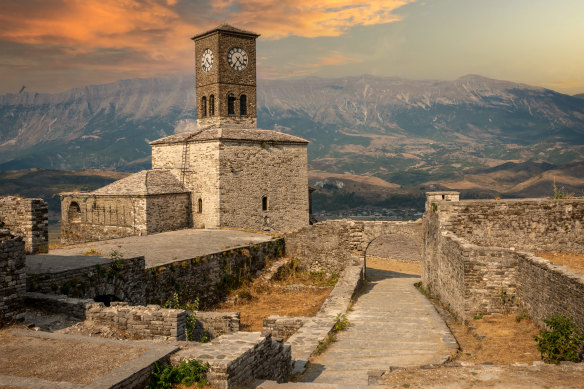
Gjirokaster Castle dominates the valley below.Credit: iStock
Gjirokaster Castle, the citadel that glowers over the town and dominates the river valley below, looks like the Ottomans have only just left. I’m surprised we didn’t pass Albanian leader Ali Pasha on the road up here, to be honest. It’s impeccably preserved and has been anachronistically but tastefully filled with captured artillery from the various wars that have ebbed and flowed through here. There’s even a United States Air Force plane perched on one of the upper open-air galleries, supposedly a trophy of the 1950s Cold War.
There have been renovations, of course, and Albania’s last monarch, King Zog, expanded the prison in 1932. Hoxha stuck his political opponents there during his spiteful regime.
There is a Gjirokaster Museum inside, shockingly expansive views from the battlements, and it’s also the venue for the National Folk Festival, which occurs every five years.
As mentioned, Kadare wrote of his “grey immemorial city”, that “many things in it were simply bizarre, and others seemed to belong in a dream”. Indeed, Gjirokaster still has much of the fairytale about it, despite the dull homogeneity and pressures of our 21st century. It’s as if a Brothers Grimm story has jumped off the pages, become real, and is sitting around telling tales in the poetry and prose of stone.
The writer travelled at his own expense
The details
Fly
Various airlines fly from Australia to Tirana, the Albanian capital in the country’s north, but there are no direct flights. Check the major comparison sites for details and prices. Alternatively, you can fly to Corfu via Athens and take the ferry across to Saranda, which is closer to Gjirokaster in the south.
Travel
There are no trains in Albania but air-conditioned buses (or the smaller minibus-style furgons) regularly ply the Tirana-Saranda route, leave from the Regional Bus Terminal not far from the airport. The trip takes about five hours and costs from €12 (about $20). The albaniatourguide.com website is excellent for bus and general tourist information.
Car hire is another option. The main roads are all excellently maintained (though less so in rural areas), and Saranda and the south are well signposted. Take the coastal route for the best views but be aware that Albanians can drive like lunatics. The ferry from Corfu to Saranda takes about 30 minutes (60+ for the car ferry) and costs from €20 ($32), depending on the season. Booking is recommended (see either finikas-lines.com or ionianseaways.com).
Eat
Albanian cuisine is very much like the rest of the Mediterranean, with lots of olive oil, fruit, vegetables, meat, and fish. A popular and cheap snack is the byrek, a flat pie made of layers of filo pastry filled with cheese and spinach or meat and onions. Pizza is pretty ubiquitous.
Currency
The Albanian currency is the Lek, though the Euro is widely used. Credit cards are accepted in the major destinations but in remote areas cash is king. There are currency exchanges everywhere. Beware ATMs – charges can be eye-watering.
More
albania.al
Sign up for the Traveller Deals newsletter
Get exclusive travel deals delivered straight to your inbox. Sign up now.